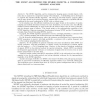Free Online Productivity Tools
i2Speak
i2Symbol
i2OCR
iTex2Img
iWeb2Print
iWeb2Shot
i2Type
iPdf2Split
iPdf2Merge
i2Bopomofo
i2Arabic
i2Style
i2Image
i2PDF
iLatex2Rtf
Sci2ools
104
click to vote
CORR
2010
Springer
2010
Springer
The MUSIC Algorithm for Sparse Objects: A Compressed Sensing Analysis
The MUSIC algorithm, and its extension for imaging sparse extended objects, with noisy data is analyzed by compressed sensing (CS) techniques. A thresholding rule is developed to augment the standard MUSIC algorithm. The notion of restricted isometry property (RIP) and an upper bound on the restricted isometry constant (RIC) are employed to establish sufficient conditions for the exact localization by MUSIC with or without noise. In the noiseless case, the sufficient condition gives an upper bound on the numbers of random sampling and incident directions necessary for exact localization. In the noisy case, the sufficient condition assumes additionally an upper bound for the noise-to-object ratio in terms of the RIC and the dynamic range of objects. This bound points to the superresolution capability of the MUSIC algorithm. Rigorous comparison of performance between MUSIC and the CS minimization principle, Basis Pursuit Denoising (BPDN), is given. In general, the MUSIC algorithm guarant...
Related Content
| Added | 09 Dec 2010 |
| Updated | 09 Dec 2010 |
| Type | Journal |
| Year | 2010 |
| Where | CORR |
| Authors | Albert Fannjiang |
Comments (0)

